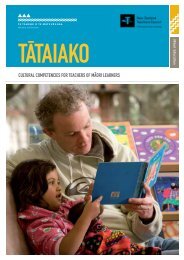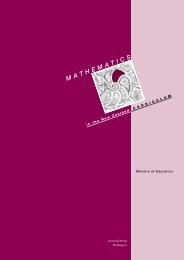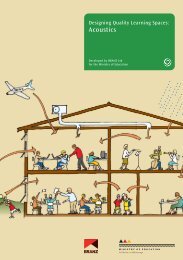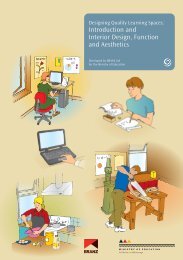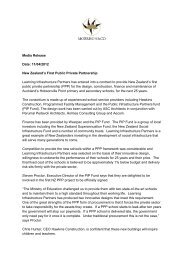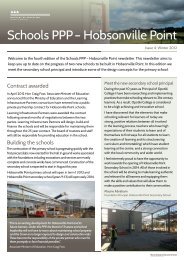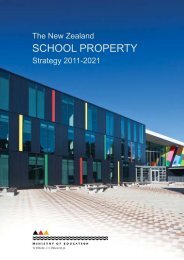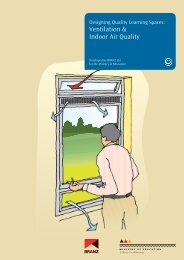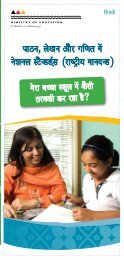values in the new zealand curriculum - Ministry of Education
values in the new zealand curriculum - Ministry of Education
values in the new zealand curriculum - Ministry of Education
Create successful ePaper yourself
Turn your PDF publications into a flip-book with our unique Google optimized e-Paper software.
allows Māori children to grow and have confidence and pride <strong>in</strong> <strong>the</strong>mselves “to achieve to<br />
<strong>the</strong> best <strong>of</strong> <strong>the</strong>ir ability” (p. 26).<br />
Te reo. Pere (1997) notes that language is <strong>the</strong> “lifel<strong>in</strong>e and sustenance <strong>of</strong> a culture [which<br />
also serves to] transmit <strong>the</strong> <strong>values</strong> and beliefs <strong>of</strong> a people” (p. 9). Mutu (1998) agrees,<br />
stat<strong>in</strong>g that te reo provides a unique means <strong>of</strong> dist<strong>in</strong>guish<strong>in</strong>g identity for tribal groups and<br />
underscores a plethora <strong>of</strong> idioms and nuances specific to such groups.<br />
Tikanga. Durie (1998) notes that custom as a def<strong>in</strong>ition <strong>of</strong> tikanga “does not denote a<br />
static set <strong>of</strong> rules” (p. 21). He expands on this,, stat<strong>in</strong>g that tikanga are “guides to moral<br />
behaviour” which are <strong>of</strong>ten determ<strong>in</strong>ed through consensual processes, based both on <strong>the</strong><br />
issue at hand and on tribal precedents. Accord<strong>in</strong>g to Durie, tikanga “is as much a<br />
comment on process as it is on fixed attitudes or knowledge” (p. 23).<br />
Taonga. A misconception <strong>of</strong> taonga, which is <strong>of</strong>ten def<strong>in</strong>ed as treasure, is that it is an<br />
object thus imply<strong>in</strong>g notions <strong>of</strong> belong<strong>in</strong>g and/or ownership. For Māori, taonga is more<br />
about <strong>the</strong>ir role <strong>in</strong> <strong>the</strong> safekeep<strong>in</strong>g <strong>of</strong> all th<strong>in</strong>gs precious and particularly highly prized<br />
resources. In this way, say<strong>in</strong>gs such as “he taonga te mokopuna” (<strong>the</strong> grandchild is a<br />
treasure) denote a much stronger bond and responsibility for <strong>the</strong> protection <strong>of</strong> such<br />
treasures. Taonga was <strong>in</strong>terpreted <strong>in</strong> Article Two <strong>of</strong> <strong>the</strong> Treaty <strong>of</strong> Waitangi as mean<strong>in</strong>g<br />
o<strong>the</strong>r objects, which, <strong>in</strong> a Māori sense extends beyond physical objects and refers also to<br />
cultural properties such as language, land and family (Durie, 1998, p. 23).<br />
Bishop and Glynn (1999) state that a metaphoric mean<strong>in</strong>g <strong>of</strong> taonga tuku iho, which <strong>the</strong>y<br />
translate as cultural aspirations, is “<strong>the</strong> cultural aspirations Māori people hold for <strong>the</strong>ir<br />
children” (p. 11).<br />
Whakawhānaungatanga. Bishop and Glynn (1999) def<strong>in</strong>e whakawhānaungatanga after<br />
Bishop (1996), as be<strong>in</strong>g <strong>the</strong> process <strong>of</strong> establish<strong>in</strong>g relationships <strong>in</strong> a Māori context. Used<br />
as a way <strong>of</strong> address<strong>in</strong>g Māori concerns about research, Bishop and Glynn ma<strong>in</strong>ta<strong>in</strong> that<br />
relationships or whakawhānaungatanga – <strong>the</strong> way <strong>the</strong>y are established, ma<strong>in</strong>ta<strong>in</strong>ed and<br />
manifested – is a valid educational research tool that connects researchers with those <strong>the</strong>y<br />
are research<strong>in</strong>g, creat<strong>in</strong>g relationships that ensure accountability and commitment. This is<br />
manifested through whānau <strong>of</strong> <strong>in</strong>terest research groups, whereby collaborative story<strong>in</strong>g<br />
Values <strong>in</strong> <strong>the</strong> New Zealand Curriculum: A Literature Review 27



